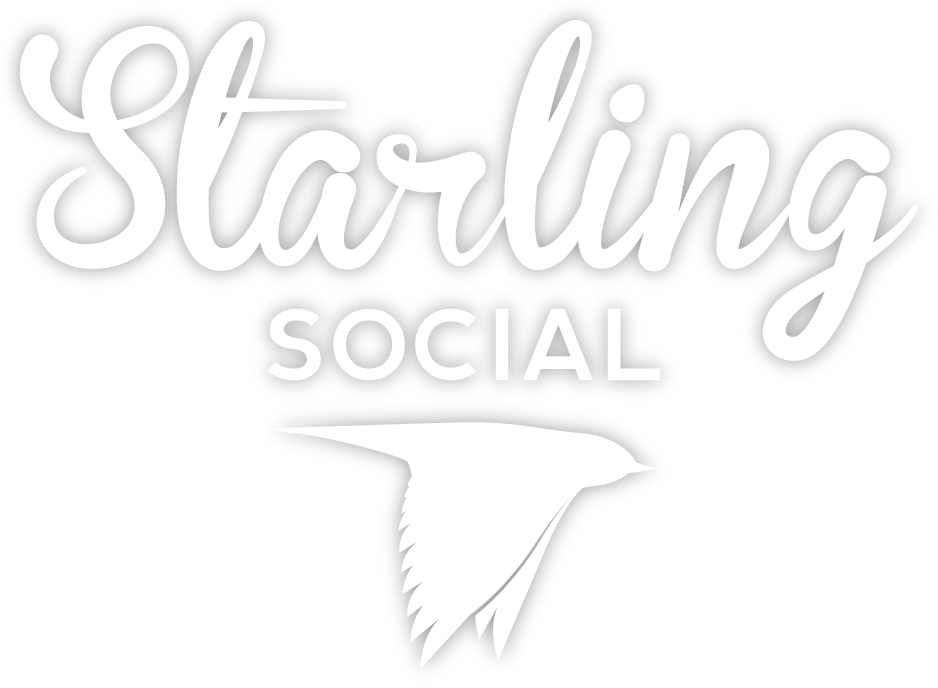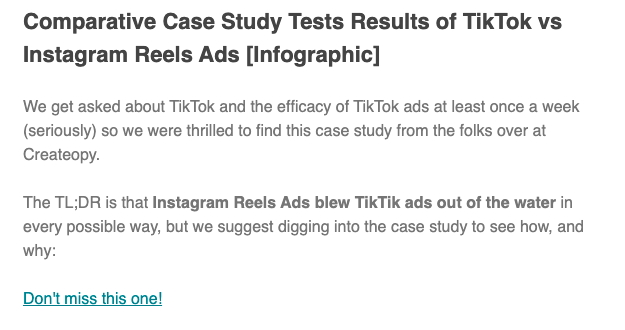Tagged: Content Marketing
7 Content Promotion Strategies That Work (with Examples)
- by Luke Thiessen
One of the greatest lies that we have adopted from pop culture (in my humble opinion) is “if you build it, they will come.” Anyone who has started a business or worked in marketing knows this just isn’t true. A more appropriate idiom when it comes to marketing is, "if a tree falls in the forest but nobody hears it, does it make a sound?"
Likewise, if you are creating great content, but you don’t promote it, who’s going to see it?
The internet is a loud and busy place where it can be tough to break through the noise and be seen and heard. But there are also plenty of strategies you can use to promote your content and get it in front of the audience you want. Let’s look at seven specific content promotion strategies that work, along with some examples to get you going.
1. Repurpose and repackage your content
One of the best strategies for getting eyes on your content is simply repackaging it for different channels.
Using your blog post, video, podcast, or whatever it is, think about what it could look like on Facebook, or YouTube. If your content is text, use it as a script to create a video, and cut down a few versions for different platforms. If your original content is a long-form video, trim it down for Instagram and TikTok.

With a bit of creativity and effort, most quality content can be repurposed into another format – and by covering as many formats and platforms as you can, you’ll reach your audience where they are more likely to see it. Bonus points if you can keep each piece of repackaged content a little different, for those seeing it in multiple places!
2. Email marketing
If you have an email newsletter (and you probably should!), this is one of the best places to promote your content. The people subscribed to your newsletter are already interested in your work, and email remains one of the most effective free (or nearly free) marketing tools around.
At Starling Social, we use our newsletters to promote our blog posts (like this one!), as well as useful digital marketing news and tips from across the web. You may even be reading this because you followed a link in one of our emails. Woah.

Whether it’s a blog post, a video, podcast episode, or any other piece of content, let your most loyal audience know by including it in an email newsletter. The format also makes it very easy to share and save; don’t be shy asking your readers to do just that within your email either.
3. Guest posts
One of the most difficult – but also most rewarding – ways to promote your content is by securing guest posts on other blogs and websites. This can be tricky to break into without help, but if you have relationships with other bloggers or websites within your industry, take advantage of them.
In a recent Starling Social newsletter, we shared an article on guest posting from Semrush, which gives a great overview of the benefits and how to do it well.
Ultimately, guest posting means getting your content published on someone else’s website, which can lead to new audiences seeing your content, increased visibility and authority, and even bumps to your SEO (if the site allows a backlink to your website and original content).
4. Online communities
Another high-labour, high-reward strategy is participating in online communities related to your work. This can be time-consuming, because it really only works if your participation is genuine, and members of these communities are often very good at sniffing out spam.
But, if you have the time, it can be worth your while to find places like Facebook groups and Reddit communities related to your business, join them, and engage organically. Once you have a feel for the rules – spoken and unspoken – you can begin to look for opportunities to share your content.
Reddit in particular can be pretty hostile to brands and self-promotion, although many Facebook groups have rules against it too. However, in the right context, done in good faith, you can win new audiences and customers in these spaces. My rule of thumb is to treat these spaces like you’re overhearing a private conversation in a public space, and realize you have something valuable to share. Be respectful, explain that you may have something of credible value to share, and offer it freely. It’s still a gamble, and you might get shut down, but you may also gain a new loyal customer or audience.
5. Internal links and evergreen content
On the lighter-lift end of the spectrum, utilizing internal links and a variety of evergreen content is a good strategy for promoting more of your content to people already visiting your website.
Anytime you are creating a new post, find opportunities to link back to previous posts and other places you share content in order to keep eyes and attention on your content for as long as possible. Also, where possible, it is great to maintain some evergreen content that you can link back to regularly, like this Starling Social blog post about evergreen content. (See what we did there?)
6. Partnerships with other brands or influencers
It can come in many different forms, but partnering with others – another company, a publication, an influencer – is a great way to get your content in front of a new audience.
A more traditional (and still very effective) way of doing this is to partner with another business – ideally one in your same field, but not a direct competitor – and conduct or commission some kind of study or survey. You get the initial benefit of sharing the cost and effort to gain (hopefully) valuable data, but you can also publish the results jointly, and benefit from each other’s audience and marketing efforts.
With the advent of influencer marketing, another way to do this is to simply pay someone to create content about your business. Usually this is less of a partnership and more of a transaction, but depending on the size of your business (and the influencer’s following), you could find opportunities for true partnership that benefits both parties and raises your profiles in tandem.
7. Paid online advertising
Finally, as much as we all love to find a free way to promote our business and content, sometimes the most effective strategy is to simply pay for some ads.
That isn’t to say that paid advertising is the easy way out – it still takes strategy and creativity, and many ads fall flat with little or no return on investment.
When paying to promote content, specifically, you can go from a simple boosted post on Facebook or Instagram (which can certainly be effective), all the way to coordinated social media and PPC campaigns that get people to sign up for your newsletter, or even pay money, in exchange for some piece of downloadable content.

The latter option here can be pricey, but if you are building up a newsletter email list from scratch, or have some truly valuable content that you want to sell, it can pay for itself quickly and easily – if you do it right.
Start promoting your content
These strategies can go a long way toward getting the attention you want for your content, but before you invest your time (or money) into promoting it, your content needs to be good!
High-quality, useful content that people want to read and come back to is the starting point of any good content strategy.
If you need help with creating or promoting your content, we’re here to help! From copywriting to social media management to paid social and PPC advertising, our team can create content that will make your business stand out, and help ensure it reaches your target audience every time. Get in touch today to book a discovery call!
Why You Need To Define Your Brand Voice In Your Copywriting
- by Luke Thiessen
A strong and consistent brand voice is hard to achieve.
Go too generic and your copy will be forgettable, or easily confused with another brand. Use too much slang, cultural references or colloquial language and you risk not being understood. But strike that balance between clear writing, distinctive personality and consistent delivery, and your content will stick – because it is memorable, effective, and uniquely yours.
Many smaller brands and businesses, especially when starting out, think they don’t have the time to develop their brand voice, or believe that their own personal voice and style is all they need. My hot take: You are hurting your brand and stunting its potential.
While a well-defined brand voice may feel like a “nice-to-have” for brands with limited resources, I’m here to say that it’s worth the investment, and may pay off in ways you didn’t expect.
Authenticity
We talk a lot about authenticity here at Starling Social, and that’s for a reason. In a recent blog post, I wrote about how brand authenticity wins over marketing perfection every time – and that is inextricably linked to having a strong brand voice in your copywriting.
People respond to authenticity. A lot of research and surveys are bearing this out lately, showing that Millennials and Gen Z consumers are especially inclined to support brands they see as authentic and aligned with their values. (Check out that post for some of the data!)
I sometimes hear clients worry about alienating people – concerned that by focusing too narrowly on their target audience, they may lose potential customers who don’t see themselves in that profile. But here’s the thing: authenticity is attractive, even when it isn’t in the mirror.

What I mean to say is that we aren’t just attracted to what matches us perfectly. Sure, we like brands who show that they are like us in some way, that they understand us, but they can also be aspirational, or draw you in because of what's different. Which leads us to…
Connection to your audience
A well-defined brand voice helps foster connection to your target audience. That includes both existing and new customers. Your copywriting can (and should!) be doing a lot of things at once, and one of those things should be cultivating a personality that connects authentically with your audience.
Done well, your brand voice should be appealing to your audience, help earn their trust and loyalty, and ultimately be something they are proud to adopt as part of their own identity.
One of the best-case scenarios for any brand is a repeat customer who brags about supporting your brand to their family and friends. And, along with the quality of (or experience with) your product, your brand voice and story is often what will help make that happen.
To be clear, this isn’t just for physical or retail brands. The exact same principles can be true and helpful for nonprofit organizations, health or professional services, restaurants and beyond. Some industries can be trickier when defining a brand voice, but getting that established will make all of your marketing and copywriting even easier.
Reinforcing your brand story, mission and values
For any brand, part of your connection to your audience is your brand story, your mission, and your values. These are increasingly important to consumers, especially younger ones seeking brands that reflect similar values.
While your brand voice is different from your mission statement, story or values, they should be compatible, and a natural extension of each other. Your copywriting is an opportunity to reinforce these things, and doing so in a well-defined brand voice should help that to feel authentic and natural.
I’m not asking you to beat your customers over the head by repeating your mission statement in every post, or with cliche reminders of your brand story at every turn – but making casual reference to these things and incorporating the language you use in them can help strengthen all aspects of your copywriting, marketing and brand overall.
A place to start
Every copywriter and marketer has had the experience of staring at a blank screen, willing the content to come (not telling whether or not that was me when starting to write this blog… Shh.)
While hopefully you have some direction for every piece of copy you have to write, having a defined brand voice can actually help you here too. Part of that brand voice should include what your voice is and isn’t, what it tries to do and what it doesn’t – and all of that can provide helpful direction for getting the creative juices flowing.
Many creative types (myself very much included) agree that they work better with more constraints or within some kind of box. Let your brand voice be a set of guardrails and help push your copywriting forward.
Differentiation from A.I.
A new and emerging concern for marketers and writers is the juggernaut of A.I.-generated content. While A.I. can be genuinely helpful in our industry in a lot of ways, the content it produces is still often easy to spot.
It’s not just A.I. “hallucinations” or false information you have to watch out for – it’s also personality and voice. Even the highest-quality A.I. copy will lack personality and fall short of what a great copywriter can do with a well-defined brand voice.
Not sure where to start?
If you need help developing your brand voice, or a great copywriter in your corner to help deliver it, we would love to chat. Get in touch and find out how Starling can take your copywriting to the next level.
Our Content Marketing Checklist for 2025
- by Luke Thiessen
It’s the start of another new year, and for us marketing professionals, that means planning season.
Now that you’ve slept off the holiday hangover (literally or figuratively, I won’t judge), it’s time to think about the year ahead, and what that means for your content marketing.
I’ve put together this content marketing checklist for 2025, filled with ideas and insights for how to make the most of your efforts this year.
1. Develop content themes
Depending on your business or industry, this can be an easy and energizing place to start your planning, or the complete opposite – but either way, it is always one of the most important.
Do you have any big plans for the year? New products launching? A rebrand or major campaign? A key event or season that drives a lot of what you do? These are great top-level priorities for your content. Not only are they the things you’ll want to talk about most, but they can become inspiration for broader supporting themes to fill your year of content.
For instance, your new product launch can complement a broader theme of innovation or quality. Your end-of-season sale could be supported by a broader theme of providing value. Or you could pair the launch of a capital fundraising campaign with evergreen content themed around impact and community.
All of this is a lot more challenging, however, if your business or organization doesn’t have much new or exciting to talk about. Without big campaigns, sales or announcements, it can feel tough to keep things fresh and relevant.
But there’s good news – if you aren’t finding content inspiration by looking within your company, you can look outside. Even when we aren’t changing, the world around us certainly is. Look around your industry for changes and trends to respond to. Consider your customers and think about what is changing in their world. Get curious and try zooming in and out on different aspects of your business, industry, customer base, or even the broader economy and world.
2. Identify key topics and keywords
Once you have your themes outlined, it’s time to think about key topics and keywords to use in your content marketing.
Starting with the themes you’ve established, some of these can (and probably will) also be terms and phrases that are common and specific to your industry. Put on your SEO hat and think about how people might be searching for the kind of content you’re making, and use variations on those topics and keywords to try and capture that in a thorough way.
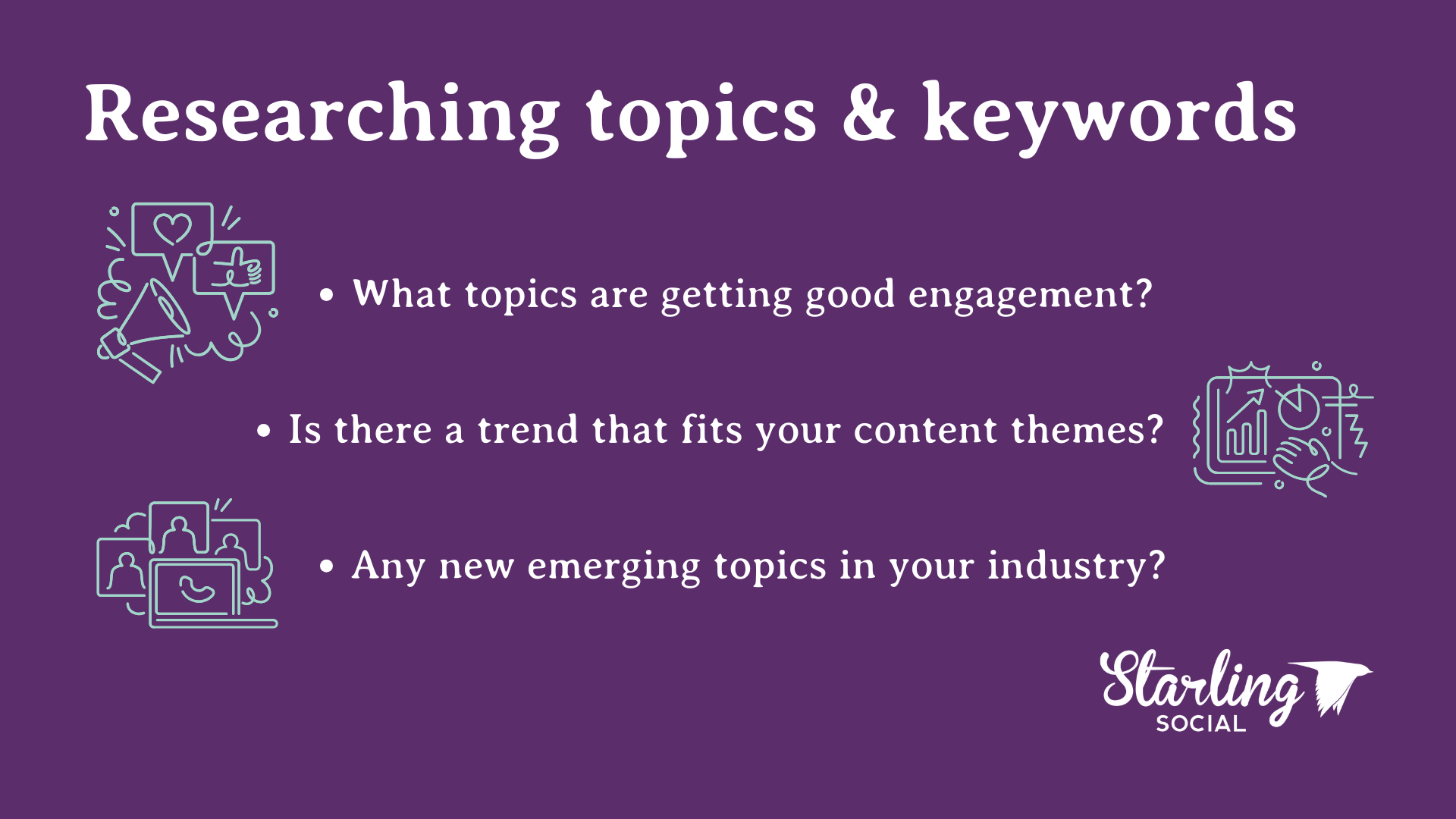
To really go above and beyond with your keywords, you should also be doing some research. Get onto the various platforms where you are publishing your content, follow some accounts within your industry doing good work, and look for things like:
- What topics or keywords are getting good engagement on other accounts?
- Is there a new trend or topic in your industry that you’ve missed?
- Are there any emerging topics within your content themes that you should include?
3. Research your audiences
A common mistake I see in marketing is people not researching their audiences often enough.
So you already defined your audience back in 2008? That don’t impress me much. (Sorry, Shania Twain…)
Like I said in our first point in this content marketing checklist – even if your organization hasn’t changed, your customers, donors or clients might have.
.png)
This doesn’t need to be done every year, necessarily, but I do recommend keeping this on your checklist every year, and at least considering if your audience needs an update. Ask yourself (or your team, or client) the following:
- Is our audience aging?
- Do we have a new, younger cohort aging into our product/service/audience?
- If our audience has grown, who are the new people?
- If our audience has shrunk, are there people we want to win back?
- Where is our audience online, and has that changed?
That last one is probably the most important, and the one that could be changing most often. One of the best content marketing tips I can give you is to research your audience’s media diet – meaning where they are consuming content, what kind of content they’re consuming, when, and how much.
There are many ways you can learn these things about your audience, from surveying your existing customer base, to social media analytics, to research done by other firms available online.
Once you’ve answered these questions and done some research, you can better focus your content themes, and prioritize the channels and formats that best suit your content strategy.
Which leads us to…
4. Prioritize formats and channels
Hopefully you already have some idea of what platforms, content types and formats work well for you and connect with your audience. But once you’ve done the work in the checklist items above, you may find yourself wanting to shift some effort from one platform to another, or consider adding a new channel or type of content.
Remember, there are many types of media you can include in your content marketing. To name just a few:
- Blogs
- Video content
- Podcasts
- Webinars
- Case studies and white papers
Something we’re thinking about this year is the value of the “Twitter alternative” platforms, Threads and Bluesky, but for you it may be something different.
We're here to help
If you’ve read this far, you clearly see the value in being proactive and intentional about your content marketing for 2025. But maybe your team doesn’t have the time, capacity or skills to really make the most of your content marketing.
We’re here to help. Book a discovery call today to see how our team of content marketing experts can help you make the most of your content and digital marketing this year!
How to Do Content Marketing Beyond Blogging: Podcasts, Webinars, and More
- by Alyson Shane
Written by Starling Social President, Alyson Shane
I’ve been publishing content online since 2002 and have watched firsthand as the world of content marketing has changed dramatically in that time.
Once upon a time we were all just a bunch of bloggers in the “blogosphere” listing our favourite sites on our blogrolls, but over the past decade-and-change the way and place we publish and share our content with our audiences has become almost unrecognizable from where I first started out.
So today I want to dig into the evolving landscape of content marketing: where it’s been, where it is, and where it’s going — all do you can develop a strategy that connects you with more of your target audience than ever before.
Let’s get into it:
Why Does Content Marketing Matter?
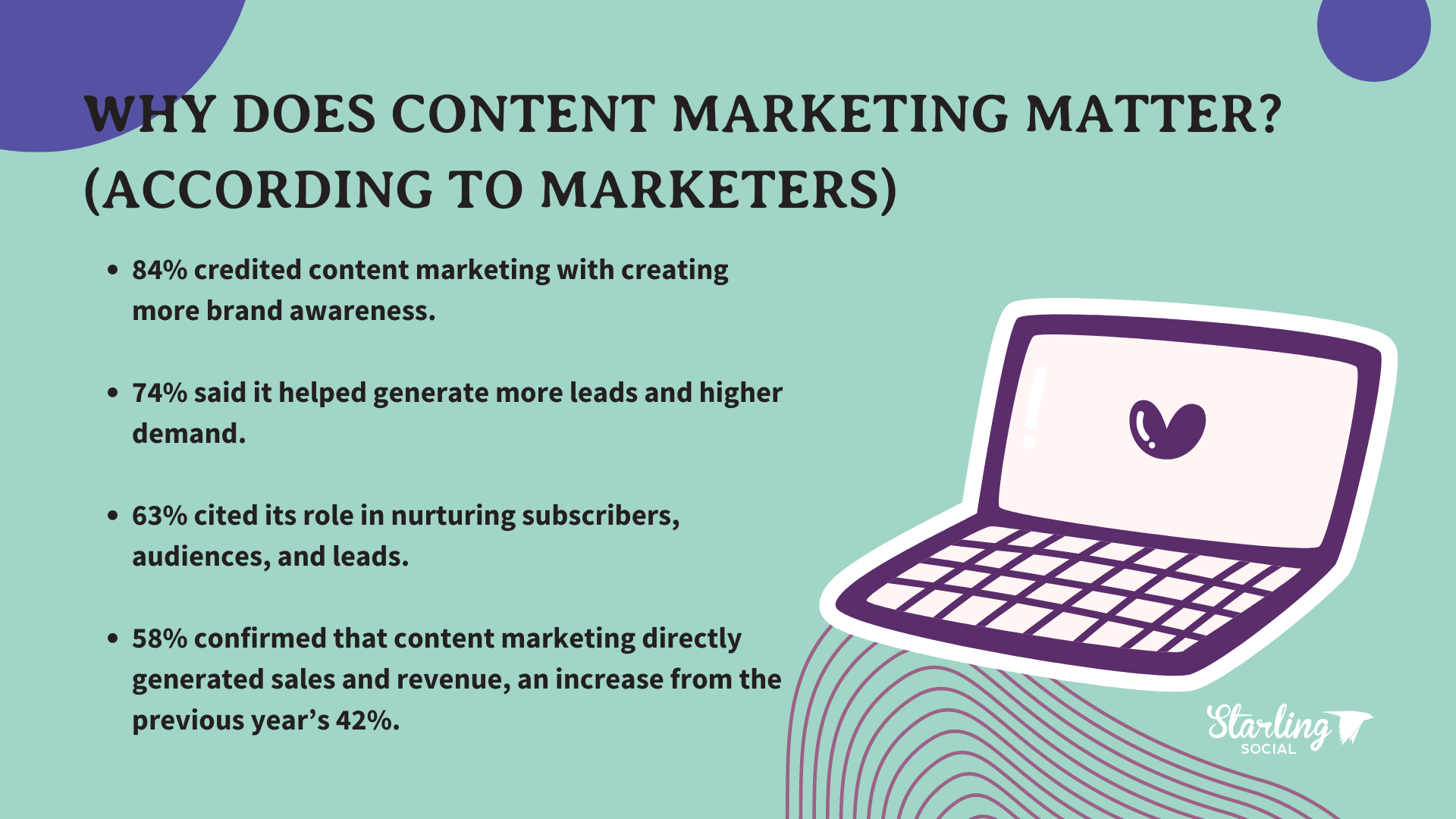
Content marketing describes a type of marketing that “involves the creation and sharing of online material (such as videos, blogs, and social media posts) that does not explicitly promote a brand but is intended to stimulate interest in its products or services” (thank you, Oxford Dictionary).
It’s also the most powerful way to continually reinforce your brand’s message, values, and convey the ways your products and services make your customer’s lives better.
But don’t just take my word for it, according to the Content Marketing Institute (CMI), marketers have been seeing success with content marketing across the board.
Here are a few stats to back that up:
- 84% credited content marketing with creating more brand awareness.
- 74% said it helped generate more leads and higher demand.
- 63% cited its role in nurturing subscribers, audiences, and leads.
- 58% confirmed that content marketing directly generated sales and revenue, an increase from the previous year’s 42%.
It’s clear that finding more ways to share your content with your audience has a net positive effect on your business, but before we dive into all the avenues available to you, let’s quickly review how we got to where we are:
The Evolution of Content Marketing
1994: The First Banner Ad
All the way back in 1994, AT&T ran a banner ad on HotWired.com and earned a click-through rate (CTR) of 44%. These results have the industry completely shooketh, and established a precedent for how companies would start turning to the internet to connect with their customers.
1995: Amazon Introduces Customer Reviews
Weird to think that Amazon has been around this long, but it’s true!
Allowing customers to say whatever they wanted about the products they were buying through the site created avenues for two-way conversations with brands that didn’t exist before.
It also opened up the floodgates for new opportunities for companies to gather real-time feedback from customers before social media exploded onto the scene.
1996: Microsoft Launches “NetMeetings” and Webinars
Although the term “webinar” wouldn’t be popularized until 1998, the first public “web conferences” were already gaining popularity.
Since then we’ve seen the introduction of more sophisticated tools like Google Meet, Zoom, GoToWebinar, ClickMeeting, and more.
1998: Google Changes Everything
Google and its PageRank algorithm is arguably one of the most important developments to ever happen to the internet.
By prioritizing a website’s “relevance” it changed websites from static spots online, to places where businesses regularly began to develop and publish content to improve their digital exposure, setting the groundwork for the SEO sector and brand visibility online.
1999: RSS Feeds
RSS feeds scrape content from sites you connect it to, allowing you to access information in one handy dashboard as soon as it’s published.
These tools didn’t become popular until the early 2000’s, but stayed the dominant way people accessed content until social media essentially ate its lunch.
2000: Google Launches AdWords
Google AdWords (now Google Ads) launched in 2000 and allowed advertisers to pay to show their ads at the top of search engine results pages (SERPS).
By 2002, they were paying by click, which is where the expression pay-per-click (PPC) originates from. This technology allowed marketers to display relevant ads only to people who were searching for exactly what they were selling, making this one of the most powerful forms of online advertising.
2003: WordPress Launches
Internet veterans like me will remember sites like Geocities, LiveJournal, and Blogger.com that came before WordPress, but this tool and its WYSIWYG (What You See Is What You Get) interface democratized the ability for anyone, anywhere, to make a website.
2004: Podcasts Enter the Scene
In his 2004 piece for The Guardian, Ben Hammersley described this new audio format as “downloadable as you wish” with Apple launching iTunes 4.9, which had podcast support, the following year.
(Fun fact: 2005 was when I started listening to podcasts!)
2005: YouTube Launches + “Inbound Marketing” Becomes a Thing
The first YouTube video was posted by one of the platform’s founders. Called “Meet Me at The Zoo” it was a potato quality, 19-second video that would go on to revolutionize how marketers and content creators alike published and shared content.
That same year HubSpot coined the term “inbound marketing” in an effort to show that producing relevant, and helpful material was the best way to build relationships with customers.
2007: The iPhone Launches
This is arguably one of the most important developments of the internet age.
The iPhone and its groundbreaking interface allowed marketers to develop content specifically for mobile devices and paved the way for the app ecosystem we have today.
2007: Facebook Launches Business Pages
The introduction of Facebook Business Pages allowed companies to publish content on the platform that would show up in users’ feeds, giving them a whole new way to connect with their audiences on social media.
2011: BuzzFeed Explodes
BuzzFeed was ranked the 13th most popular blog in the world in 2011 and made engagement tactics like quizzes, calculators, and YouTube videos cross-posted to the site incredibly popular.
2012: Facebook Buys Instagram
Facebook paid around $1 billion for Instagram that year and changed the way social networks relied on paid advertising and influencer marketing, with Sponsored Posts being introduced in 2013 and putting a focus on collaborative content with users on the platform.
2013: Google Hangouts On Air Make Webinars More Mainstream
The introduction of this service allowed users to broadcast seminars, live sessions, and conferences to massive audiences for free, allowing the webinar industry to reach a global audience.
2013: Snapchat Introduces SnapChat Stories and Vine Launches
Snapchat’s Stories needed to be timely, relevant, and in some cases participatory because they would disappear after 24 hours, and laid the groundwork for a trend in content marketing that would eventually be copied by every single other social media platform.
That same year Vine popularized the publication of short-form content, eventually inspiring TikTok and Instagram Reels.
2016: Google Introduces Mobile-First Indexing
In response to the quickly-growing number of people using mobile devices, Google announced that it was shifting to “mobile-first” indexing, forcing marketers to focus on content that was optimized for smaller screens and adapting their SEO strategies accordingly.
2018: TikTok Launches
TikTok exploded onto the scene in 2018, paving the way for marketers to reach a global audience of yonder people and catapulting short-form video into the mainstream to be copied like platforms like Instagram (2020), YouTube (2021), and Facebook (2022).
2020: The Rise of Zoom
I’d be remiss if I didn’t include the rise of Zoom as the go-to platform for businesses, schools, and regular people during the pandemic.
Webinars had been around in the pre-pandemic years, of course, but being forced to pivot to online-only events helped solidify this type of content into the mainstream.
2022/2023: AI On The Rise
AI started to become mainstream with the launch of ChatGPT 2022, but it wasn’t until 2023 when OpenAI released GPT-4 in 2023 that it really became a mainstream tool.
Now, AI tools like ChatGPT and others (we list some here) are changing the way content is created more quickly than ever before.
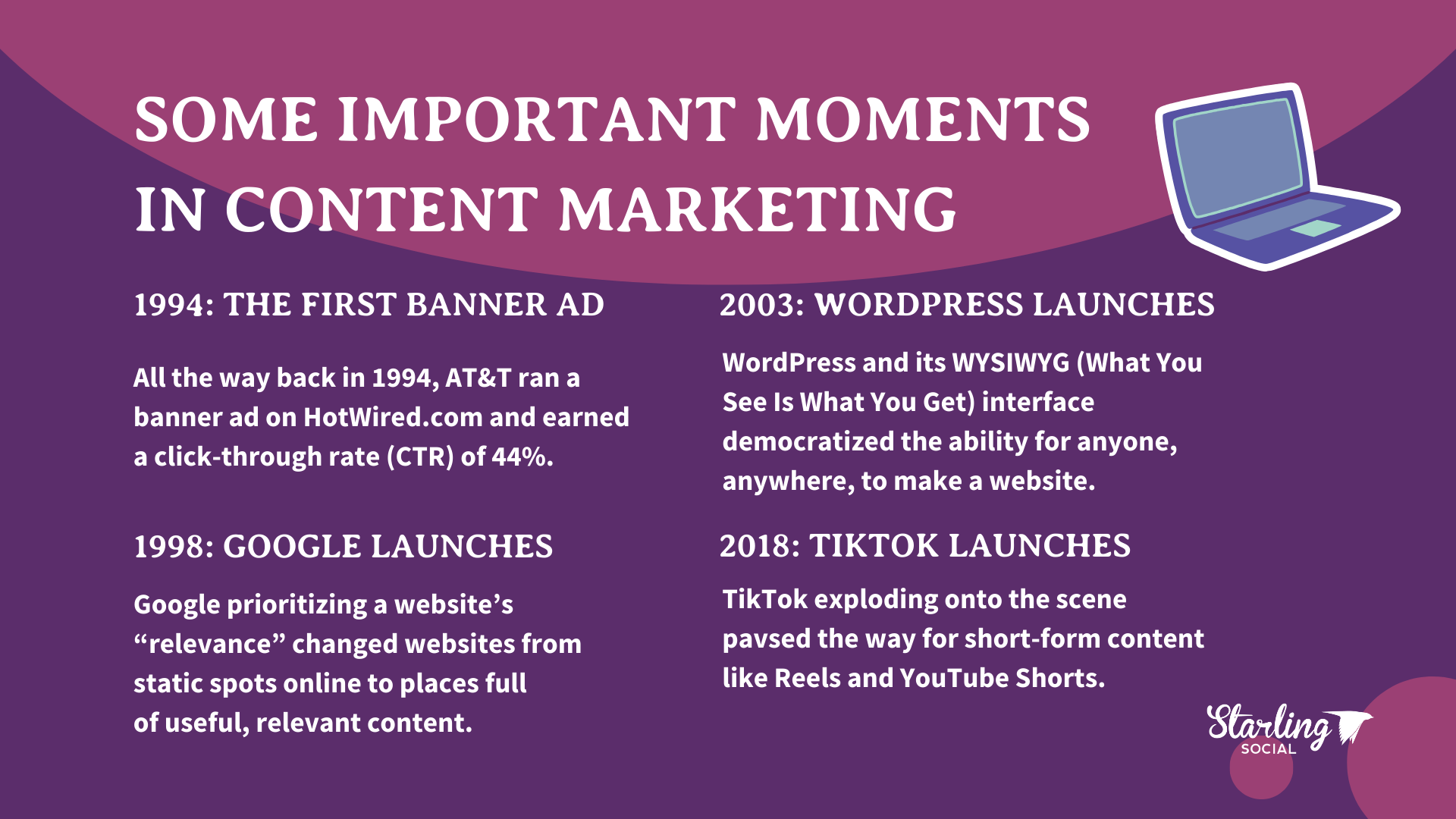
Types of Content Marketing
Blogging
Of course I had to start here, with the “OG” type of content marketing.
Blogs (like this one) are still among the most important types of content marketing for several reasons, including:
- Building trust in your brand. Being able to articulate what you know about your industry and educate people about it shows that you know what you’re an expert in your field.
- Increasing website traffic. Blogs are still an important part of your search engine optimization (SEO) strategy. Not just because you can include important keywords in your content, but also because blogs engage readers for longer periods of time than landing pages, which increases SEO value.
- Driving conversions and sales. When someone lands on your website and reads your blog, it helps them learn more about you and what you offer, which increases the likelihood that they’ll reach out.
- Increasing link-building efforts. Linking to authoritative sources in your blog content, like a product manufacturer, page that has data to back up your writing, or other “reputable” website helps improve your search engine ranking.
- Repurposing blogs for social media. You’ve probably noticed that we share 2-3 posts on average per blog post to our social feeds, not to mention when I promote them on my personal LinkedIn. This is a “bricks and feathers” approach to content marketing that works really well, and reduces the burden on you to constantly come up with unique content for every social media post.
But enough about blogs. Let’s explore some of the other types of content marketing you should be leaning into:
Video Content
Vidyard found that the average video retention rate for videos across the board is 54%, making this type of content one of the most impactful kinds you can create.
Video marketing is continuing to evolve, but some of the most popular types of videos you can create are:
- Instagram Reels
- Facebook Reels
- TikTok videos
- YouTube Shorts
- Livestreams
The possibilities here are really endless. You can create tutorials on YouTube; short, snappy TikToks and Reels with trending audio and sounds; and everything in-between.
One example I really like is Old Spice’s “The Man Your Man Could Smell Like” campaign that launched back in 2010. The videos featured actor Isaiah Mustafa (aka the "Old Spice Guy") in a variety of weird and silly situations speaking directly into the camera in an exaggerated way.
This campaign re-positioned Old Spice as a brand that didn’t just cater to older men, but was attractive to trendy, young people, too. The campaign was so successful that Old Spice’s sales skyrocketed by 107%.
Infographics
Humans have been creating infographics since the pre-internet period, but this type of content is especially useful at conveying information online since users’ attention spans sit at around 8.5 seconds.
While infographics can be effective, there are a few ground rules to keep in mind:
- Plan your infographic and use it to build on the narratives you’re already telling with your other content.
- Use headings and subheadings to increase “readability” and keep users engaged.
- Lean on tools like Canva, Piktochart, and others to easily create scroll-stopping graphics.
- Consider making infographic templates for yourself to make creating new ones fast and easy.
Podcasts
Like I said above, podcasts have been around for ages, but only recently have become one of the more popular ways for brands and marketers to get their message out there.
Podcasts can help you reach a wider engaged audience who are interested in your industry and expertise. Some of the ways you can use podcasts are:
- Interviewing guests, experts, and influencers.
- Sharing insights on trends, news, and spicy topics.
- Increasing your visibility through platforms like Apotify, Apple Podcasts, and Google Podcasts.
- Build a loyal and active community around your brand.
Protip: If you don’t have time to host your own podcast, look for podcasts in your niche and pitch them on being a guest on the show. I do this all the time and get a lot of traction and awareness about Starling Social from my interviews!
Memes
If you follow us on social media, you know we love a good meme.
Memes are a form of cultural expression that spread through variation and imitation, and can be images, videos, text, music… you name it, these days it’s probably meme-able.
Memes are effective forms of content marketing for the following reasons:
- They showcase your brand personality, voice, and sense of humour.
- They relate to your audience and their challenges and pain points.
- They engage with your audience and encourage them to like, comment, and share your posts.
- They show you’re “tapped in” to current cultural trends and have your finger on the pulse enough to create entertaining, relevant, and engaging content.
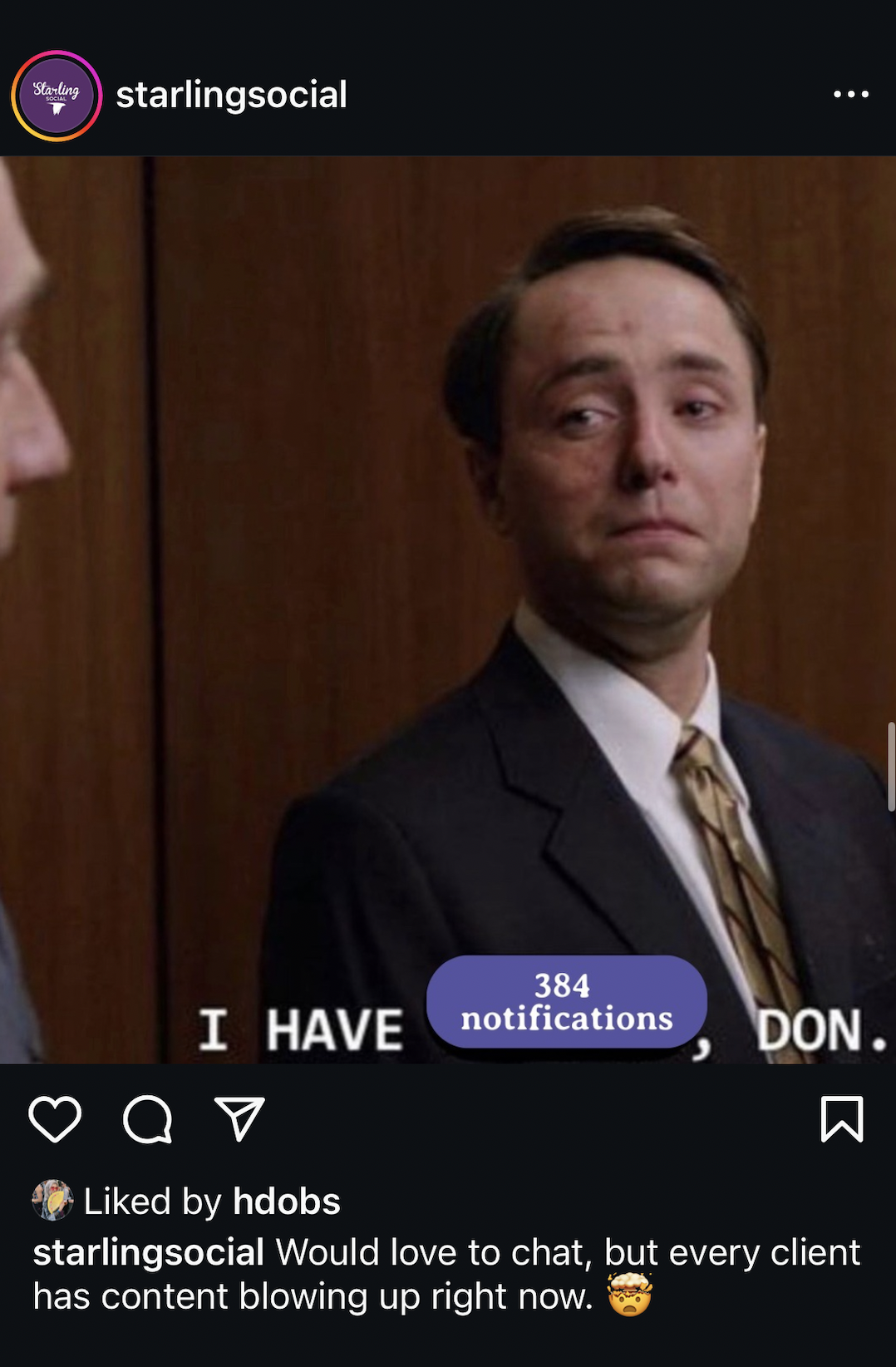 |  | 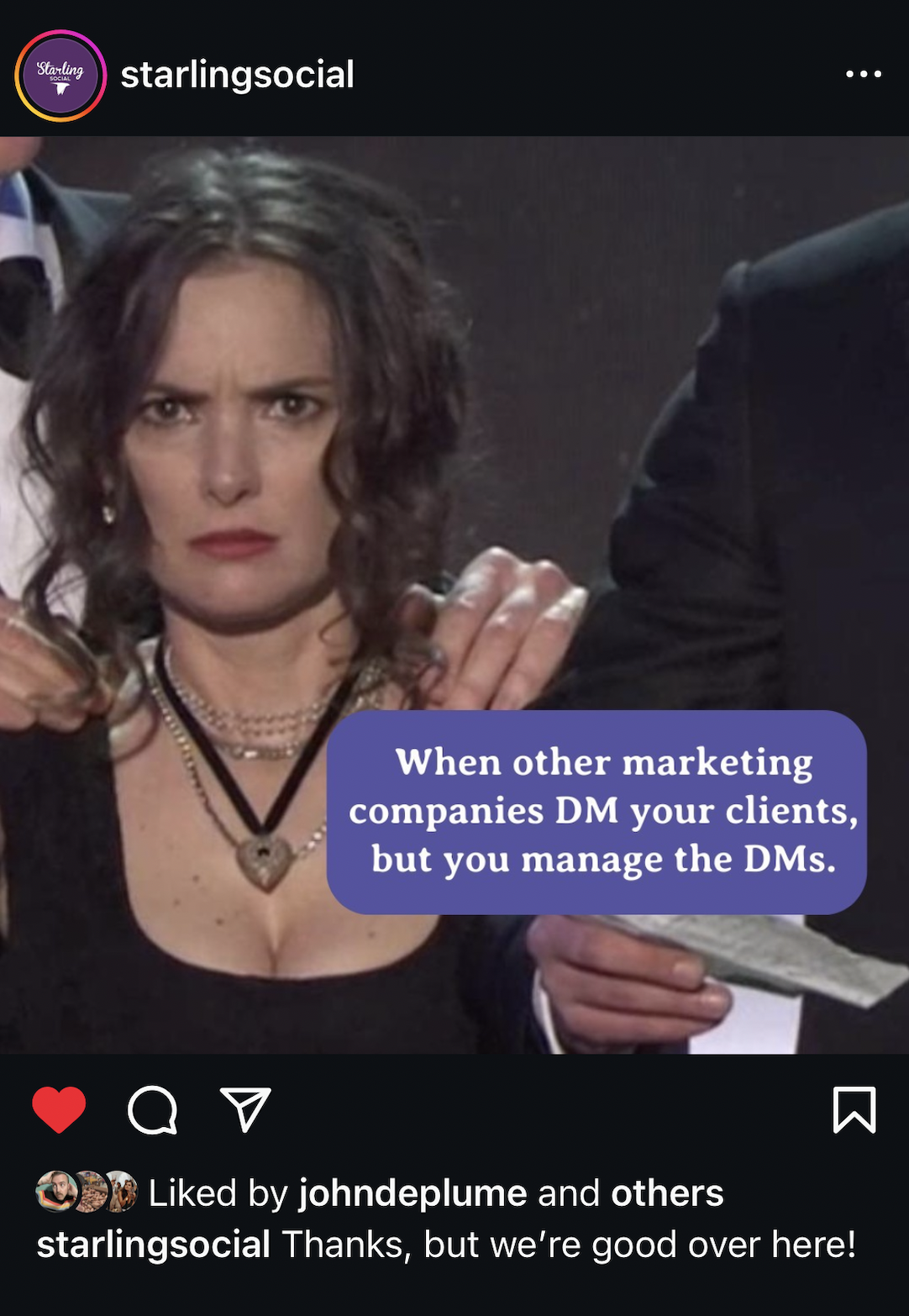 |
Webinars
Webinars are a great way to generate brand awareness because they position you as a subject matter expert and give you a platform to educate and empower your audience.
They also reinforce you as a subject matter expert who can easily talk about specific topics, ideas, or strategies related to your industry.
Because webinars are delivered digitally, they also allow you to reach a broader online audience of people who might not have heard about you otherwise.
You can host your own, or partner with other brands and organizations to develop and deliver your webinars to a specific audience. For example, I’ve delivered dozens of webinars as a facilitator with Volunteer Manitoba since 2017, which has allowed me to connect with nonprofit organizations in my community who I might not have been able to reach otherwise.
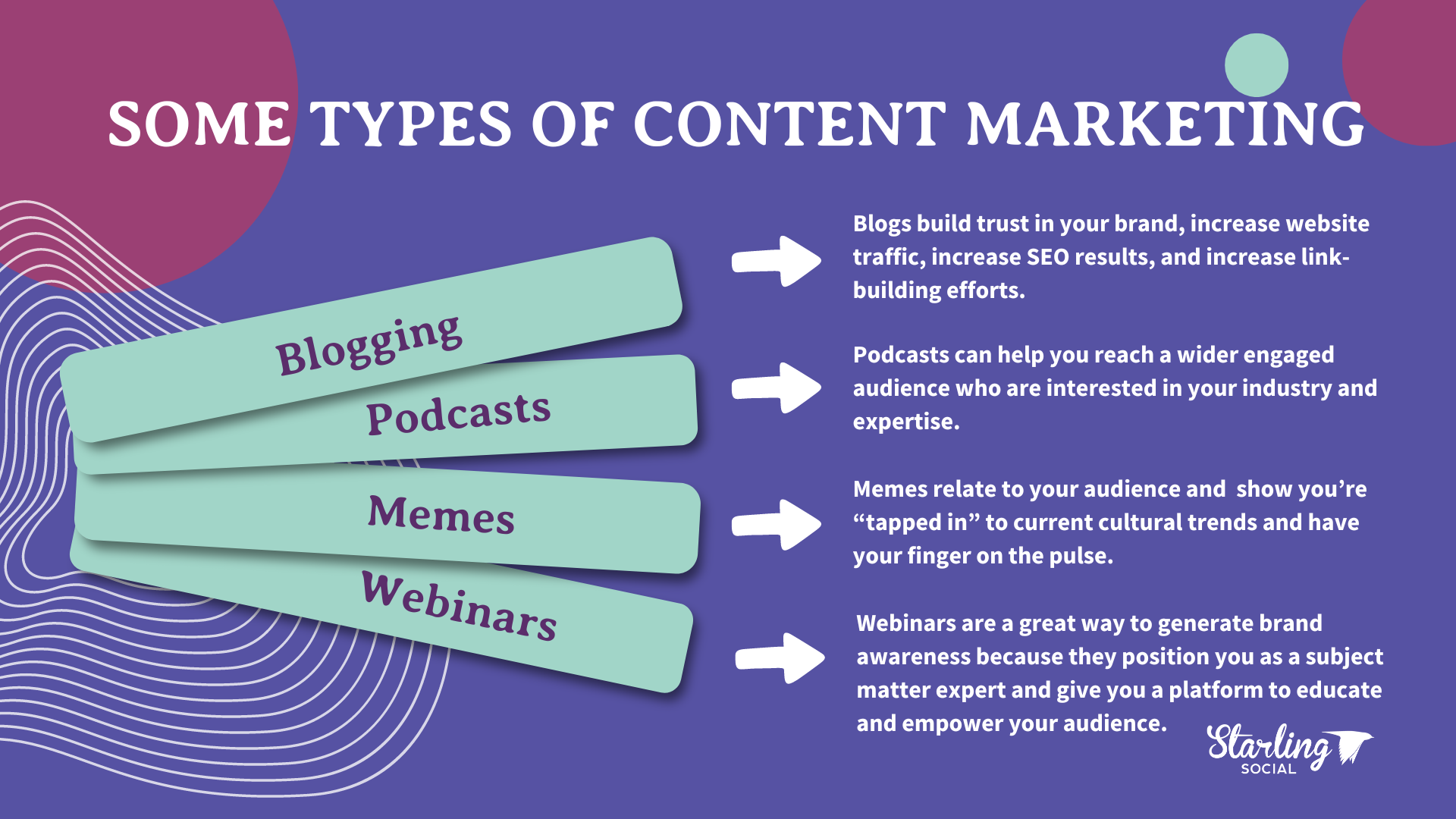
eBooks
Before you clutch your pearls at the thought of writing a whole book, think of it as long-form blog content instead.
eBooks aren’t novels; they’re multi-page ads for your business that reinforce you as a subject matter expert and empower potential clients and customers with information that builds trust.
One great example is The Experience Optimization Playbook by Optimizely, which explores optimization strategies from Fortune 500 companies.
Case Studies and Whitepapers
Case studies can be time-consuming to create, but are a great way to tell a story about how your product or service helped your customers achieve a specific outcome or goal.
With this type of content, your audience can see a customer’s journey from start to finish and see similar use cases in real life.
A great example from LinkedIn shows how HSBC used LinkedIn’s marketing tools helped them diverse the way their marketing content is presented:
While whitepapers and eBooks are both examples of long-form content, they’re not the same thing.
Whitepapers are more densely-packed with information and data than most eBooks, and are detail-oriented where eBooks are more high-level.
User-Generated Content (UGC)
UGC is one of the easiest ways to gather content that tells a positive story about your brand, your products and services, and how they help real-life people.
People respond more positively when they hear stories told from people like them and can turn viewers into customers much more quickly than a lot of other content types out there.
One example of UGC I really like is from Doritos. They launched a site called Doritos Legion of Creators where users can create branded images and videos that Doritos shares on their social media accounts.
Users have come up with all sorts of content, from snack-centric weather forecasts, to pictures of themselves laying back in piles of nachos, and more. The company keeps creators engaged by creating challenges like the “oddly satisfying challenge” which invites creators to create oddly satisfying videos for the chance to be featured on their Instagram Stories.
Testimonials + Reviews
Like UGC, testimonials and review-based content are generated straight from your audience and their experiences with your products and services.
This type of content is especially impactful if your business is operating in a niche market, because testimonials can act as overviews of what sets you apart from the competition.
You can see examples of how bigger companies like Nike use them, too; their Instagram feed is pretty much all celebrity endorsements and reviews.
Grow Your Business with Content Marketing
Content marketing doesn’t just drive immediate results; it’s a long-term investment in your company’s future and brand awareness goals.
By creating relevant, valuable, and high-quality content, you can attract new customers to your business and keep them coming back for years to come - and the best part is that you don’t need a huge marketing budget or team to do it!
How to Scale Up Your Content Marketing Efforts
- by Alyson Shane
Whether you're a small business looking to expand your online presence or a seasoned marketer looking for a new level of success, the answer lies in a well-crafted content strategy.
As businesses grow and expand, scaling up content marketing efforts can be challenging.
Scaling up your content marketing efforts requires careful planning, strategic thinking, and the right tools and resources. It involves increasing the quantity and quality of your content while maintaining consistency and relevance to your audience. Let's break down the essential components of content marketing and content strategy.
The Importance of a Well-Defined Content Strategy
When you have a clear strategy in place, companies can effectively reach their target audience and drive engagement.
It helps businesses understand their needs, interests, and pain points. With this understanding, companies can create content that resonates with their audience, establishing a connection and building trust.
A solid content strategy allows businesses to plan their messaging across various channels and platforms consistently. This consistency enhances brand recognition and strengthens brand identity.
A well-defined content strategy enables organizations to measure their efforts' success accurately. Businesses can track engagement metrics like website traffic, social media interactions, and conversions by setting clear goals and key performance indicators. This data provides valuable insights into what works best for their target audience, allowing for continuous improvement and optimization.
Step 1: Developing Systems and Workflows for Efficient Content Creation and Management
If you know anything about the Starling team, you know that our owner loves good, trackable, and efficient systems.
These systems optimize content creation efforts, enhance collaboration among team members, and guarantee a seamless workflow from ideation to publication.
One tool that the Starling team leverages for content creation and collaboration is Google Docs. With its real-time editing capabilities and cloud-based storage, teams can work together on documents simultaneously, eliminating the need for time-consuming back-and-forth exchanges. This allows for efficient feedback loops and ensures everyone is on the same page throughout content creation.
Another valuable resource for developing clear workflows (that our team also loves) is Trello. This project management platform enables teams to organize tasks, track progress, and set deadlines in an easy — and visually appealing — interface. By creating boards with lists and cards representing different stages of the content creation process, teams can easily manage assignments, prioritize tasks, and monitor overall productivity.
Embracing these tools saves time and fosters a more productive work environment where creativity thrives alongside effective project management practices.
Step 2: Understanding the Role of SEO in Your Content Strategy
Search Engine Optimization makes your content irresistible to search engines. It's all about finding the right keywords and optimizing your content to rank higher in search results.
a) Who to Target with Your SEO Efforts?
Before you start, get to know your audience inside out. Create buyer personas first. Buyer personas are fictional representations of your ideal customers, complete with demographics, interests, pain points, and behaviours. This helps you think about what your audience is searching for, and tailor your content to their needs.
Next, dig deep into user intent keywords. People type these key phrases into search engines when seeking answers or solutions. Rather than just focusing on generic keywords, consider your audience's specific questions and problems. What are they searching for, and why?
Imagine your audience's journey and thought process.
- What challenges do they face?
- How can your content address those pain points?
By aligning your content with their needs, you attract more visitors and build trust and credibility.
b) What to Focus on When It Comes to SEO?
Pay attention to technical SEO factors like site speed and mobile-friendliness. Google loves websites that load quickly and look great on smartphones. Also, focus on creating high-quality content that's relevant and valuable to your readers.
c) Why Is SEO Essential for Successful Content Strategy?
SEO isn't just a buzzword; it's the key to building organic growth. When you rank higher on search engines, you attract more visitors. And guess what? Those visitors are more likely to convert into customers.
d) Where to Incorporate Keywords Within Your Content?
Sprinkle your keywords strategically throughout your content. Use them in your title tags, meta descriptions, headings, subheadings, body text, image alt tags, URLs, and even within your internal linking structure. Just remember, don't overdo it; keep it natural.
Step 3: Effective Distribution Channels for Amplifying Your Content Reach
Creating engaging content is only half the battle. You also need to make sure it reaches the right audience. Enter distribution channels.
Social media platforms like Instagram, LinkedIn, TikTok, X.com, Facebook, Pinterest, YouTube, etc. are your megaphones. Share your content there, engage with your audience, and watch your reach grow. Don't forget the power of email marketing campaigns. We could go on about that, but for time’s sake, here’s another blog about writing a killer newsletter.
Consider guest blogging or podcast opportunities and influencer partnerships. Collaborating with others can introduce your brand to a whole new audience.
Step 4: Crafting Your Content
Now that you've laid the groundwork for your content strategy, it's time to craft your content. Don’t put out a social media post for the sake of putting out a social media post! Make sure your content is helping you reach one of your goals.
If your post doesn’t fit into these boxes, should you really be posting it?
Relevance: Always keep your target audience in mind. Craft content that directly addresses their needs, interests, and pain points. Your content should be a solution to their problems.
Quality: Research thoroughly, fact-check rigorously, and provide valuable insights. High-quality content establishes your authority and builds trust with your audience.
Consistency: Maintain consistency in your posting schedule, brand voice, style, and messaging. This consistency creates a reliable and recognizable content identity your audience can trust.
Timeliness: Keep your content up-to-date and relevant to current trends and industry developments. Being on top of the latest news and updates positions you as an industry thought leader.
Education: Offer valuable insights, tips, and actionable advice. Providing educational content positions your brand as a valuable resource in your niche.
Entertainment: Incorporate storytelling, humour, and engaging visuals to make your content enjoyable. Entertaining content is more likely to be shared and can increase your content's reach and impact.
As you craft your content, consider how these pillars can be integrated into your pieces.
The Power of a Well-Thought-Out Content Strategy
We’re lucky to have an incredible team at Starling who truly cares about the success of each client. These tools are the gears that keep the engine running, but the true power lies in the well-thought-out content strategy. It ensures that every piece we create serves a purpose, resonates with our audience, and contributes to our overall success.
We don't just advocate for these tools; we rely on them to help execute our content strategy.
Google Docs: Google Docs is where we create drafts and collaborate seamlessly. This makes crafting a strategy that aligns with your overall content goals easier.
Trello: Trello helps us break down our content strategy into actionable steps, ensuring that each piece aligns with our overarching goals.
Buffer: Buffer helps execute a carefully designed distribution plan. It ensures our content reaches the right audience at the right time. Other tools like Later and Hootsuite accomplish the same goals and may be the right choice for your biz.
Remember, tools are only as effective as the strategy behind them. Craft your strategy with care, and adapt it as needed.
Or, if you are ready to focus on big-picture items and leave your marketing to the professionals, contact us here to book a consultation.
What North American Companies Can Learn From Japanese Ad Campaigns
- by Alyson Shane
If you’ve ever seen a Japanese ad or commercial, you’ve probably watched it and said, “wtf is this” — and you’re not alone.
Having just spent a month in Japan, I was struck by the stark difference between Japanese and North American advertising. Their ads often feature people in costumes, anthropomorphic items and animals, and characters making silly or exaggerated faces and sounds.
Aka, it's the complete opposite of most of the marketing campaigns I've seen here in North America.
As someone obsessed with marketing and storytelling, I loved being immersed in a different culture and seeing how Japanese brands market their products and services.
In this post, I’ll explore how North American companies can find more engaging and memorable ways to connect with their audiences by embracing silliness and being weird the way Japanese brands do.
Let’s start by comparing some ads:
Cup Noodle Japan
Predictably, Cup Noodle is a brand of instant noodles popular in Japan. I saw ads for these on subway trains all over the country, and they often involved people in weird situations interacting with a life-size cup of noodles.
Let’s start with a Japanese Cup Noodle commercial:
Now let’s take a look at an ad for instant noodles from another Japanese company that’s targeted at North Americans, Ottogi America Inc.:
Night and day, right? While some aspects of the Japanese commercial might not necessarily land with a North American audience (the grandpa being held by a Cup Noodle angel at the end is a weird vibe), the ad is fast-paced and unpredictable and basically the opposite of what you’d expect from a company selling cups of noodles.
God of War: Ragnarok
I didn’t actually see it while I was in Japan, but I wanted to include it because it does a great job of showcasing the contrast between how North Americans market something and how they do it in Japan. Check it out:
I read the Google Translate description of the video, and I’m still not 100% sure what’s going on here.
Now let’s compare it against the American trailer:
I actually love both versions of these ads, but the contrast is pretty stark: the North American version relies on celebrities. It comes across as more satirical (and tame) than the Japanese version.
It also portrays playing the game and dressing like Kronos as the men are trying to be better dads to their kids — framing GoW, Kronos’ beefy physique, dressing like a Viking, and playing a violent videogame as “masculine.”
The Japanese version, by comparison, contrasts what arguably sounds like a children’s song against a violent, pretty macho video game.
SoftBank’s “White Family”
I don’t remember where or how I discovered this series of ads back in the early 2000s, but these weird, quirky commercials stole my heart and probably set me up for the love of Japanese marketing that I still hold today.
The long-running campaign, which focused on the (Shirato) White Family headed by Otousan (“Father”), who is a white dog, was one of the most successful and long-running ad campaigns in the country’s history.
As of 2012, the campaign had reached 133 “episodes,” but here are a few to give you a sense of what they’re like:
(Also, don’t sleep on the Tommy Lee Jones cameos!)
As you can see, very few of these commercials actually talk in detail about the phone company or the plans themselves. Mostly they’re little vignettes about the family and the things they’re doing.
The commercials are weird, but they’re also charming and memorable.
Now let’s look at a North American ad that also features a talking animal:
Did you notice that Geico’s ad followed a lot of the same tropes that the SoftBank ads did?
By featuring an unusual animal who talks (and who is kind of abrasive to the humans around it, just like Otousan), they can create a quirky, memorable ad that promotes their offerings without being too heavy-handed about it.
Differences Between Japanese and North American Ads
Now that we’ve looked at a few examples, let’s break down the key differences between ad styles according to research:
Style Differences
- Japanese commercials are less informative than American commercials.
- Japanese commercials emphasize product packaging and availability, while American ads emphasize price, quality, and performance.
- Japanese commercials use a soft-sell approach with short messages, songs, celebrities, female voice-overs, and still graphics.
- American commercials use a hard-sell approach with long messages, animation, male spokespeople, and humour.
Cultural Differences
- Japan is a ‘high-context society’ whose communication needs are answered through familiar symbols and icons rather than logical recommendations.
- The US is a ‘low-context culture’ requiring Western rhetoric and logical tradition to communicate thoughts and actions.
What Can North American Brands Learn?
Be Weird
As you may have noticed, a key element of Japanese advertising is being silly and weird.
Japanese ads often feature bizarre imagery (see below for an example), unusual characters, and unexpected scenarios. By embracing the unexpected and breaking away from traditional advertising tropes, companies can create more memorable and engaging ads. Weirdness can also help companies stand out in a crowded advertising landscape.
Key takeaway: Don’t be afraid to lean into weird, memorable characters or make them a bit annoying or unlikeable for the sake of the joke.

Why is that pistachio so smarmy?!)
Use a “Soft Sell” Approach
Japanese commercials often use a soft-sell approach with short messages, songs, celebrities, female voice-overs, and still graphics.
This approach can be more subtle and less aggressive, which can be more appealing to some audiences.
Key takeaway: Avoid being too heavy-handed. Tell a story that resonates or excites your audience where the product you’re promoting comes second to a memorable ad.
Use (and Create!) Familiar Symbols and Icons
As we saw in the SoftBank ads, Otousan became something of a cultural icon in Japan. By incorporating or creating characters who can become cultural symbols (think the polar bears for Coca-Cola), campaigns become more easily recognizable and familiar to audiences.
Experiment with Pattern Interrupts and Pacing
As we saw with the Cup Noodle commercial and how a few SoftBank commercials cut between scenes, the Japanese aren’t afraid to jump around.
Cutting frequently between scenes is called a “pattern interrupt” and is an effective tool (also employed by YouTubers) to keep the audience’s attention focused on whatever they’re watching.
Many Japanese ads also end abruptly or in weird and unexpected ways. Not knowing where the plot is going is another way of keeping viewers engaged right until the very end.
Key takeaway: Don’t be afraid of experimenting with pacing and surprising your audience with a twist at the end of your ads.
Play With Satire
Although both the God of War: Ragnarok examples played with satire, the North American one played it safe by linking the GoW series to “manliness” and easily identifiable gender norms.
The Japanese ad, on the other hand, threw gender norms right out the window and went with an ad that could have easily been mistaken for a kid’s commercial.
While the North American ad is fine (I liked it, personally), the Japanese sing-song ad stands out more because it almost feels like it’s making fun of the ultra-macho GoW series instead of leaning into a predictable masculine theme.
Key takeaway: Don’t be afraid to lean into satire and juxtapose different elements of an ad against the product you’re promoting.
Get Inspired for Your Next Ad Campaign
Japanese advertising offers a refreshing alternative to traditional advertising, and North American companies can look to these types of ads for inspiration.
So, the next time you’re creating an ad campaign, consider adding a little bit of silliness, embracing the unexpected, and making fun of yourself and your product. Who knows, you might create an ad that people will remember for years to come.
The #1 Question Every Piece of Your Content Should Answer
- by Rose Regier
This guest post was written by Rose Regier.
So you’re sitting down to create some content for your digital marketing channels. You’re doing this a month ahead of time because you read this and you get why posting on the fly is a) not strategic and b) not the best use of your time.
Your first thought might be, “What’s new in our business that we can talk about? What haven’t we talked about yet? Hmmmm, do we have any nice photos to share? Should we jump on a TikTok trend? Maybe show our support for an issue everyone is talking about?”
You draft some content and are about to put it into your queue - here’s where we’re going to stop you.
Before you’re done, you need to make sure every piece of content you just drafted answers this one question:
“What’s in it for my customer?”
Running each piece of your content through your own internal “What’s in it for them” filter might be the single most important way to make sure your digital marketing is strategic.
Every person (whether they’re aware of it or not) is walking around the world trying to find what’s in it for them—as they scroll, as they shop, as they eat, and as they binge a show. They’re looking for a payoff.
We’re Wired for Connection
It might seem selfish, but actually it’s just human nature. We’re driven to connect what’s out there to our personal experience.
Brené Brown is a researcher who’s spent the past two decades studying courage, vulnerability, shame, and empathy. Here’s what she found:
“Connection is why we're here. We are hardwired to connect with others, it's what gives purpose and meaning to our lives, and without it there is suffering.”
Understanding this fundamental drive will change the way you relate to your customer and also deepen your relationship with them.
This is also why getting to know your ideal customer is so important. You can’t relate to everyone, so you need to understand the specific people with whom you’re trying to connect, to know what they want from you.
Part of the client onboarding process at Starling Social is creating your ideal customer personas. The exercise itself is often very clarifying for our clients, and from there we can use these personas as a reference when we’re crafting your content, so we can act as an extension of your brand.
All this talk about connection and meaning might sound a little deep for a digital marketing strategy, but this doesn’t mean your content has to be serious. You don’t have to strike at the heart of your customers’ desires and pain points every time. It could be that sometimes your customer is looking for a little escape, for beauty, for some entertainment, or for a laugh.
In addition to considering what your customer wants from you, how you connect also depends on your brand. If you’re not sure what your brand is, start with our post on brand questions by Chelsée Curé.
Finding Your Content Sweet Spot
Your brand + what’s in it for your customer = your content sweet spot
The more you hit that content sweet spot, the more likely it is that your customers will want to engage with your stuff.
Some companies focus inward too much and only consider their offerings when creating content. They forget that your blog and your social media channels are a conversation.
It’s kind of like going on a first date and the person you’re meeting with talks nonstop. It only takes a few minutes of this before you’re eyeing the door, and getting out of an in person conversation is a lot harder than a simple unfollow.
Asking what’s in it for your customer will ensure you don’t get tunnel vision so they keep coming back for more.
Have we convinced you? Ok great, now let’s put it into practice.
What’s In It for You: Examples
Have you seen the acronym TL;DR in our weekly newsletter? It stands for “Too long; didn’t read” and we use it to give you a quick summary of something we read so you don’t have to.
What’s in it for you? You get all the juicy info without having to read a long (and possibly boring) article, but we always include a link in case you want to dive in.
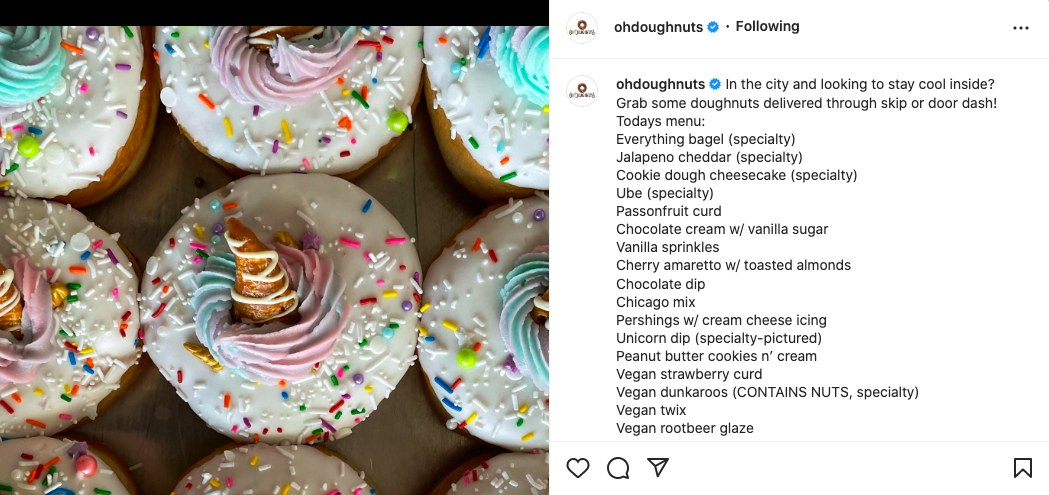
What’s in it for you? Craving doughnuts? You can take a quick peek at Oh Doughnuts' IG to pick your flavour before you head to the shop. This post also lets you know that you can have doughnuts delivered to your house, which means you don’t have to get sweaty to get doughnuts.
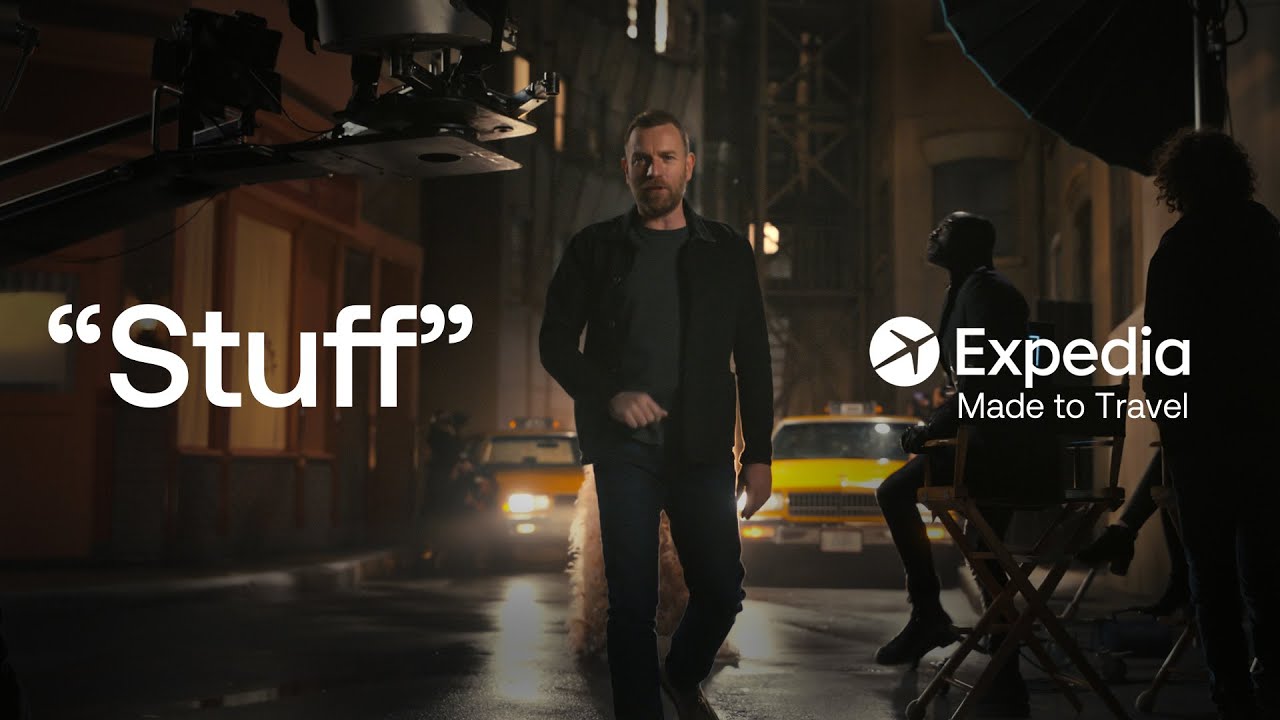
This Expedia commercial with Ewen McGregor acknowledges—and pokes fun at— our obsession with accumulating stuff, and then ends with him walking onto a white sand beach. You hear the waves crashing and see a family with two kids running into the water.
What’s in it for you? Spending your money on experiences instead of stuff will make you happier, and Expedia will help you save more on those experiences.
Its especially inspirational because most of us have spent the better part of two years stuck at home with online shopping or home renovations filling the void left by lack of travel. We’re ready to have experiences again.
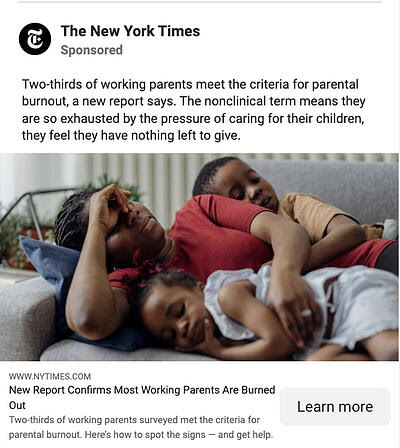
This Facebook Ad for an article by The New York Times is geared toward parents of young children. The copy and image are a great example of a company understanding its customers and where they are at right now.
What’s in it for you? Validation. Knowing you’re not alone and you’re not abnormal for feeling burnt out is a relief, plus the article offers a way out.
What Do Your Customers Want?
What do each of these examples have in common? Yes, they all make it clear what’s in it for you, but what’s in it for you in each case is a feeling rather than a product—ease, happiness, validation.
These examples hit on another fundamental truth when it comes to marketing: what your customers want isn’t just a product/service, they want the feeling that accompanies it.
Curious about how else we can help you be more strategic with your digital marketing? Get in touch! We’d be happy to answer your questions.
How to Permanently Increase Your SEO with Evergreen Content
- by Lauren Wagn
By: Lauren Wagn, Social Media Manager
We’ve all heard the phrase “content is king”, and while this is true, some kings reign longer than others.
Content is a prime tool in your business’ toolbox to drive online traffic to your website. This can increase brand awareness, brand loyalty, and sales. However, not all content is created equally. Some content will create a flash-in-the-pan of interest while others will organically build traffic over time.
This is the difference between content and evergreen content.
Evergreen content can also go hand-in-hand with SEO techniques for even more return-on-investment (ROI).
Keep reading to learn everything you need to know about how to make content that keeps on giving.
What is evergreen content?
When you hear the term “evergreen” you probably think of lush pine trees lining a snow-covered street; A tree that is thriving all year long.
That’s exactly what evergreen content is!
It’s content that no matter the time of year, or what year it is for that matter, it’ is always relevant. Evergreen content is not time-sensitive, even in a world where trends move in a blink of an eye.
The difference between evergreen content and regular content is like the difference between Wikipedia and TikTok. Wikipedia is steady and consistent, while TikTok is fast-paced and ever-changing.
Examples of evergreen content
Evergreen content can come in a variety of formats including how-to guides, testimonials, case studies, and listicles.
While the format of evergreen content can be diverse, it’s the topic that is the real distinguishing feature.
Here are some examples of evergreen content:
- The Top 3 Social Media Metrics You Need to Be Tracking. Social media isn’t going anywhere anytime soon. While the topic is niche, it will not lose its relevancy.
- How to Bake a Cake. Originally posted in 2010, this evergreen article has been updated to maintain its freshness.
- Evergreen Trees: Everything You Ever Wanted to Know. Evergreens grow all year round and are relevant all year round.
- The article you’re reading right now! Informational articles about industry-specific concepts make great evergreen content.
What these topics have in common is that none of them are tied to current events, news cycles, or trends. This allows them to sustain growth over long periods of time.
Evergreen content is built to last. News posts, announcements, statistics, and seasonal content will all age rather quickly. While there is a time and place for this type of content, evergreen content can build a strong foundation for your business’ online presence.
To compare, here are the Google Trends results for an evergreen topic next to a trendy topic.
Here are the results for “How to bake a cake”:
Versus the results for “Brangelina”:
“How to bake a cake”, while having some spikes, is generally consistent. “Brangelina”, however, was a hot topic following their break-up then flatlines into relative obscurity. This illustrates the life expectancy of these two types of content.
Why evergreen content matters
So now you know what evergreen content is, but why should you be interested?
1.) It consistently brings potential customers to your website
As evergreen content is always relevant, people will always be searching for this information. This creates a steady stream of viewers that may have never found your website before.
2.) It can drive traffic through different parts of your website
Once the evergreen content has brought the lead to the page, internal links can help boost time spent on your website. The more time they spend engaged with your content, the more likely they are to convert.
3.) It conveys information to your audience that will solidify you as an authority in their eyes
By using your content to address your audience’s problems and solve them, you can begin to build a relationship of trust with them.
How to make evergreen content with SEO in mind
When creating evergreen content, strategy and quality are equally important.
Evergreen content relies heavily on the topic it is based on. This will be different depending on what industry your business is in. We suggest picking something that you can position yourself as an authority in. What does your business know best?
When considering what topics to write about, look at frequently asked questions about your business or information that beginners may want to know.
Once you’ve determined an overarching theme, research what keywords may help your content find the right audience. Choosing a popular and heavily used keyword may lead to too much competition. Through your keyword research, you can begin to narrow down the scope of your content to form a concept that your audience will want to read.
These keywords can be used in various places in your content, such as:
- Title of the page
- URL
- Copywriting
- Meta tags
- Image file paths
- Anchor text
This will help optimize your content and help it land on search engine result pages (SERPs).
With the topic fully fleshed out, it’s time to research the competition. Put your keywords into Google and see what comes up. This is what you’ll be competing with when people are looking for information on your chosen topic.
Pay attention to the headlines, format, and depth of information in these high-ranking results.
To rank well, you’ll want to produce content that is as good, and ideally better, than what is already out there. Use your competition as a benchmark for your content.
Not only is the quality of the content valuable to the reader, but it is also valuable for SEO. By building authority and creating high-calibre content, your page can attract backlinks, which is when another website “links back” to your post.
Having other websites link you as a resource not only drives traffic from their site to yours, it also factors heavily into Google's ranking algorithm.
At this point, you can begin to outline and draft your evergreen content
Need help developing an evergreen content strategy for your business' blog? Click here to get in touch!
How to keep your evergreen content alive
Researching and creating your evergreen content makes up the bulk of the work, but maintenance of your content is still important! Just like pruning a tree, evergreen content will need to be checked on and updated periodically.
While the majority of your copy may not need any tweaks, smaller aspects may need to be adjusted. Click on any links to make sure that they are still working correctly or review any statistics that may have changed. It is also worthwhile to check the effectiveness of your keywords and edit as needed.
This maintenance will keep your content fresh, useful, and accessible to your audience.
Evergreen content tips
When creating evergreen content, here are some extra tips to keep in mind:
- Write for your audience. If you’re speaking to beginners, don’t go too heavy on industry jargon so it is accessible to everyone.
- Break it up into “smaller” pieces of content. Use your evergreen content to create smaller, bite-sized social media posts that can drive traffic back to the original content.
- Use enticing headlines to catch people’s attention.
- Don’t rely exclusively on evergreen content. Use timely content to capitalize on trends and increased searches on certain keywords too.
Conclusion: start writing evergreen content today!
Evergreen content can be an effective way to get your business on SERPs, drive traffic, connect with your audience and convert leads. It’s also a great ROI as the returns just keep on coming.
When using evergreen content, just remember to thoroughly research your topics, keywords, and competition before writing so you can create the best possible content for your audience. This will ensure that your content has the desired outcome.
Ready to create evergreen content and don’t have the resources to do it the way you want it done? Reach out and let’s talk about how we can help you create content that’s right for your audience.
Did you find this article useful and are ready to learn even more? Subscribe to our weekly newsletter and get hand-picked digital marketing tips, tricks and trends delivered straight to your inbox every Tuesday.
How to Write The Best Technical Blog Posts for Clients
- by Alicia Kurz
This post was written by our Account Manager Alicia Kurz.
Are you wondering how to write a great technical blog post for your clients?
Chances are, when you think about writing a technical blog post, your first feelings are a sense of dread, followed by being bored before you even start. If you aren’t an expert in whatever complex subject you are about to embark on, starting can be discouraging.
Luckily, these steps will help you develop a process to create useful, interesting technical content and take the guesswork out of publishing great technical posts. Let’s dive right in:
Where do you even begin?
The good news is, the thought of writing a technical blog post is more challenging than actually doing the work. The key is finding the points in the topic that interest you and focus on highlighting those points. When you’re more interested in a topic, you’ll be more enthusiastic about writing the post and finding the correct information. The better the post, the easier it is for the audience to connect with the topic.
Technical blogs are a great way to reach a lot of people and give people information that’s easy to consume. After writing many technical blogs, here’s the workflow that makes things easy to focus on content instead of logistics. Let’s start spreading some good ideas!
1. Define your audience and key messages
Who are you writing for? If your target is moms between 25-40, your writing is going to sound much different than writing for 30-50-year-old engineers in the forestry industry — am I right, ladies?
Audience personas can be quite helpful when you’re thinking about the tone and structure of your piece. A wine blog for beginners can likely be more light-hearted than a post about the environmental impacts of dust on a local community, for example.
It’s always important to think about what’s in it for your audience. People have limited time, so reading your blog better be a good use of theirs. Are the key messages of your blog in line with what your target audience is looking for? If not, you will need to make adjustments so people aren’t asking “who cares?”
2. Research your topic
Thank God for Google. Likely, you aren’t the first to write about whatever topic you are about to delve into. That’s a good thing. You have information from multiple sources — just please fact check — so it allows you to piece together the best information in the easiest to read way. Just because others have done it first, doesn’t mean they have done it best.
Often the research provided to you is written in nerd language and it’s your job to figure it out. If you’re a writer, that can be fun. It’s like fitting puzzle pieces together to make information more accessible to a larger audience.
If you have questions, other people probably do too. Your blog is where people will go to find those answers.
If you are writing this blog for a client, schedule a call where you can ask questions and make sure your key messages are clear. While you can independently find out a ton of information by yourself, it makes it a lot easier when you and your client are starting on the same page. Plus, they probably have specific information they want to be included that may not have been clear to you initially.
Make sure to record the call so you can go back and reference it. This will save you a lot of stress. It’s much easier than taking notes and trying to remember everything.
3. Create an outline
Now that you have your key messages down, you’ve researched your topic, and your client has given you an idea of what they are looking for, it’s time to create an outline.
Luckily, you have other blogs to reference and see first-hand which ones you were drawn to and which ones you pressed the back button immediately.
I said it once and I’ll say it again: always start with “what’s in it for them.” If your introduction doesn’t have a hook, your audience is gone.
Use headings and lists to make your content easy to read, and use a call to action at the end of your blog that aligns with your goals. Book a meeting, follow us on Facebook, or buy now are all great examples of how to further engage your audience after they have read your blog.
Outlines are also great to organize your thoughts and weed out excess information that will cloud your key messages.
4. Start Writing
Use your own voice to relay your messages. Whether that’s the professional version of your voice or your Saturday night version after a glass of wine version, just make sure the tone matches your content.
Use the K.I.S.S. method. In case you weren't born 60-years ago, or you just prefer to not reference rude acronyms, that means Keep It Simple, Stupid. Take out industry jargon and complicated language. You can sound smart without using words people have to Google. Your blog should be accessible to a large audience and easily consumable, not feel like more work.
5. Take a Break
Give your eyes a break once you’ve written your piece. After you stare at your computer for hours trying to write the perfect blog, you might become blind to minor errors. Maybe you typed “and” twice or used the same word in a paragraph three times. Try going on a walk, or just not looking at a screen for a couple of hours before you come back to it.
Although I prefer to save the trees, a great tip is to print your piece and edit it on paper — after you have run it through Grammarly, of course. For some reason, it’s easier to make changes that way.
Plus, it’s kind of satisfying to edit your own with a red pen… maybe that’s just me.
If you have a chance, ask someone else to read it for you. Try not to get annoyed when they give you irrelevant suggestions. They also might catch something you said twice, or ask a question about something you thought you answered, but you weren’t clear enough.
6. Add the Finishing Touches
Now it’s time to make your blog look nice. Add headings, photos, article links, and an SEO-friendly title.
7. Publish
The most satisfying part of writing your blog is clicking the publish button. Ensure the blog is going to the right part of your website, add tags, set a featured image, and utilize any widgets you have installed on your site to make your blog SEO-friendly.
After it’s published, check that the image that pulls works on your social platforms and that it loads correctly on both desktop and mobile feeds.
8. Promote
You want people to see what you’ve posted. Share your blog post in places your target audience hangs out. Ask people to share it. This gives you a chance for your network to spread your post to their network.
Use Canva to create free images that look great on social, and you don’t need to be a designer to use. You can also resize these so it fits correctly on all platforms.
If your piece is really awesome, consider doing some digital advertising for it to get the most eyes on it.
Just remember, practice makes perfect. Eventually, writing technical blogs will become more of a habit, and creating these posts will flow much easier.
If you need help writing blog posts or getting your content in front of the right people, drop us a line and let us know how we can help!
4 Research Tips to Plan and Create Personalized Social Media Content
- by Alyson Shane
In a recent workshop with The Kinship Studio, we covered the importance of personalized content and how it can increase leads and sales by making your social media content more engaging.
Today we’re going to expand on some of the tips we shared with the class - let's dive right in:
What is Personalized Marketing?
Personalized marketing is the process of using data and analysis to deliver personalized content that is tailored to specific members of your target audience.
In fact, you’ve probably encountered this form of marketing before: have you ever received a “cart abandon” email encouraging you to complete a purchase? That’s personalized content.
Another form of personalized marketing is dynamic website content.
This type of personalized content will change to reflect the person’s browsing or purchasing behavior, or will change languages and stock items (for example) based on where the person is located.
What Are the Benefits of Personalized Marketing?
Some of the potential benefits of using personalization in your social media marketing include:
- Generate more customers and leads
- Create a sense of trust and familiarity with your customers
- Increased customer engagement
- Encourage content sharing
- Improve social media relevance (and lower ad costs)
- Increase brand awareness
Now that we’ve covered the benefits of personalizing your content, it’s time to dig into where we find all that customer data from in the first place:
Source 1: Review Your Buyer Personas
Buyer personas are an essential part of your marketing strategy because they help you identify specific, unique characteristics of different customer types.
They can help you understand things like:
- Age, gender, and geographic location
- Where they spend their time online
- Which devices they use (mobile, tablet, etc)
- The topics that interest them
- The influencers they follow and engage with
We’ve talked a lot about the importance of having buyer personas in an earlier post. If you’ve never created one, check out our handy guide (with free template!) to start building yours.
Source 2: Twitter Analytics
Twitter Analytics is a treasure trove of information about the people that follow you!
Check out your followers and note the following areas:
- Their interests (broad topics like comedy, weather, and technology)
- The devices they use to sign in and their wireless carrier
- Their household income status and net worth
- Their marital status
By exploring the various tabs (Overview, Demographics, Lifestyle Behaviour, Consumer Behavior, and Mobile Footprint) you can develop a deeper understanding of how your Twitter users behave.
But you’re not done yet. Next up...
Source 3: Facebook Audience Insights
Another great place to get a better understanding of your audience is Facebook Audience Insights.
Find it by opening Ads Manager, then clicking All Tools > Audience Insights.
Facebook will ask you to choose between studying everyone on Facebook, or just people connected to your page. Unless you have a giant following, select ‘Everyone on Facebook.’
Use the information you learned when looking through your Twitter Insights to inform your research. For example, you can look up people with this kind of criteria:
- 30-55 years old
- Located in the U.S.
- All genders
- Interested in Business
- In CEO or President positions
Once you’ve set up your search, Facebook will show you in-depth information about your audience. Here, you can find things like:
- Which Facebook pages this audience likes
- Where they live
- Which devices they use
- Their job titles
- The industry they work in
- And lots more!
Source 4: Look at Your Email List
The key to building an email list that helps you understand your audience is to offer lots of ways for people to subscribe. Some ways to do this include:
- CTA buttons or embedded text encouraging readers to subscribe
- Images that pop-up or slide-in on your landing pages
- Posts about your email newsletter on your social media channels
- Varied gated content (PDFs and resources that can be accessed in exchange for an email)
Different options help you understand people’s motivations for subscribing in more detail.
Once someone has subscribed, you can track the links in the email you sent them, see if they opened your email, and more.
Use a Social Listening Tool
A social listening tool is a must-have for the type of ongoing audience research needed to excel at personalized content.
Social listening tools typically offer multiple filtering options and in-depth analytics, and allow you to stay on top of any brand mentions online.
Some of the best tools out there (depending on your budget) are:
Brand24: 14-day free trial, Pro $49/month, Premium $99/month, Max $399/month
Buzzsumo: Pro $79/mo, Plus $139/mo, Large $239/mo, Enterprise $499/mo
Sprout Social: Standard $99/user/mo, Professional $149/user/mo, Advanced $249/user/mo
Brandwatch: Custom pricing
Hootsuite Insights: Custom pricing
Start Researching Your Personalized Content Today
There’s no better time to start understanding your audience and speaking more directly to how your company solves their problems.
Delivering personalized content to your customers will help you see a higher return on investment (ROI) in your marketing efforts, and creates a more connective experience for your audience.
Do you have research tips to share? Tweet 'em at us! You can also subscribe to our weekly newsletter for news, resources, and the digital marketing news you need by clicking here.
